Breastfeeding Medication Safety Checker
Check Medication Safety for Breastfeeding
Find out if your medication is safe to take while breastfeeding using the L1-L5 risk classification system.
Important: This tool provides general information based on the L1-L5 classification system. Always consult your healthcare provider or LactMed for personalized medical advice.
When you're breastfeeding, every pill, injection, or patch you take doesn't just affect you-it can reach your baby. It’s a reality that worries new parents: Is this medication safe for my child? The truth is, most medications are. But knowing which ones are, and how they move through breast milk, isn’t common knowledge. Too many mothers are told to stop breastfeeding unnecessarily because of a lack of clear, evidence-based guidance. You don’t need to choose between your health and your baby’s. You just need the right information.
How Medications Get Into Breast Milk
Medications don’t magically appear in breast milk. They travel from your bloodstream, through the cells lining your milk-producing glands, and into the milk itself. This happens mostly by passive diffusion-meaning drugs move from areas of higher concentration (your blood) to lower concentration (your milk). It’s not a perfect filter. Small molecules under 200 daltons slip through easily. Drugs that dissolve well in fat (high lipid solubility) also cross more readily. If a drug is tightly bound to proteins in your blood (over 90%), it’s less likely to enter milk because it’s stuck to those proteins and can’t move freely.The timing matters too. Drug levels in your milk usually mirror what’s in your blood. So if you take a pill, you’ll see a peak in milk concentration within an hour or two, then it drops. That’s why timing your dose can make a big difference. Taking your medication right after you nurse means your baby gets the least amount possible during the next feeding. If you’re on a once-daily drug, take it after the bedtime feeding, when your baby will sleep the longest.
There’s one exception: the first few days after birth. Your milk is colostrum-thick, sticky, and low in volume. But the cells in your breasts haven’t fully sealed yet. That means more drugs can leak through. The good news? Your baby is only drinking about 30 to 60 milliliters a day during this time. By day five, your milk volume increases, the cells tighten up, and exposure drops even if the drug concentration stays the same.
Why Some Drugs Are Riskier Than Others
Not all drugs behave the same way. Some get concentrated in breast milk because of something called ion trapping. This happens when the pH of your milk (about 7.2) is slightly lower than your blood (7.4). Weakly basic drugs-like lithium, certain antidepressants, and barbiturates-become charged in milk and get trapped there. That can lead to milk-to-plasma ratios of 2:1 or even 10:1. That means your baby could be getting more of the drug than you’d expect.Half-life is another big factor. If a drug sticks around in your body for more than 24 hours, it’s more likely to build up in your milk over time. Drugs with short half-lives (like ibuprofen or amoxicillin) clear out quickly. That’s why they’re preferred. Oral absorption by the baby also matters. If a drug isn’t well absorbed in the gut-like many antibiotics-it won’t reach the baby’s bloodstream even if it’s in the milk. That’s why penicillin and cephalosporins are considered low risk: they’re poorly absorbed and don’t cause side effects in infants.
Topical medications are usually safer than oral ones-unless you’re applying them directly to your nipple. Creams, patches, and sprays on your arms or back rarely transfer enough to affect your baby. But if you put a lidocaine patch on your chest, or use a steroid cream on your nipple, you’re giving your baby direct access. Always wash your hands after applying anything to your breasts, and wipe off the nipple before feeding if you’ve applied something there.
The L1 to L5 Risk Classification System
Dr. Thomas Hale, a leading expert in breastfeeding pharmacology, created the most widely used system to rate medication safety during lactation: L1 to L5.- L1 (Safest): Drugs like acetaminophen, ibuprofen, and many antibiotics (penicillin, amoxicillin). These have been studied in hundreds of mothers with no reported adverse effects.
- L2 (Safer): Drugs like sertraline, fluoxetine, and metformin. There’s limited data, but no serious issues reported. These are often recommended when needed.
- L3 (Moderately Safe): Drugs like diazepam, fluoxetine (in high doses), and some antidepressants. Use with caution. Monitor baby for drowsiness or irritability.
- L4 (Possibly Hazardous): Drugs like lithium, cyclosporine, and some chemotherapy agents. Only use if benefits clearly outweigh risks. Close monitoring required.
- L5 (Contraindicated): Drugs like radioactive iodine, chemotherapy drugs like methotrexate, and ergotamine. These are rarely used during breastfeeding because they can cause serious harm.
Most medications fall into L1 or L2. Only about 1% of all drugs require you to stop breastfeeding. The American Academy of Pediatrics says the benefits of breastfeeding almost always outweigh the risks of medication exposure. Still, it’s easy to get scared. That’s why so many mothers are wrongly told to stop.
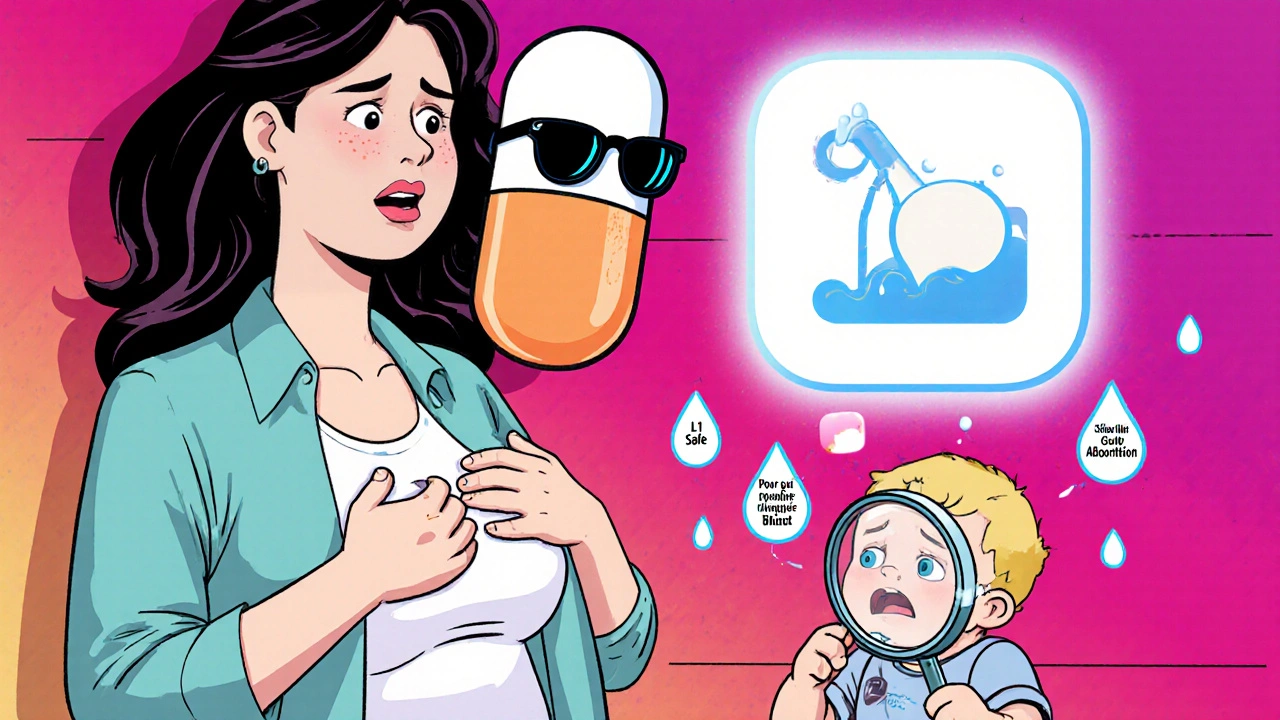
What Medications Are Most Commonly Used?
A 2022 study found that over half of breastfeeding mothers take at least one medication. The top three categories:- Analgesics (28.7%): Ibuprofen and acetaminophen are the go-tos. They’re safe, effective, and clear quickly from milk.
- Antibiotics (22.3%): Amoxicillin, cephalexin, and clindamycin are all L1. Even if your baby gets a tiny amount, it won’t hurt them. Diarrhea is rare and usually mild.
- Psychotropics (15.6%): Sertraline is the most studied and preferred antidepressant. Fluoxetine is effective but has a long half-life, so it can build up. Avoid benzodiazepines like alprazolam unless absolutely necessary.
Other common ones? Birth control pills-progestin-only are fine. Estrogen-containing pills can reduce milk supply, so they’re avoided in the first few months. Thyroid meds like levothyroxine are safe. Even insulin doesn’t pass into milk because it’s too large.
Where to Find Reliable Information
Don’t rely on Google, Facebook groups, or even your doctor’s memory. Use trusted, updated databases.LactMed, maintained by the U.S. National Library of Medicine, is the gold standard. It has data on over 4,000 drugs, including herbal supplements and vitamins. It’s free, updated weekly, and used by over a million people a year. It gives you detailed info: how much gets into milk, infant exposure levels, potential side effects, and alternatives. The downside? It’s technical. If you’re not a clinician, it can feel overwhelming.
Medications and Mothers’ Milk by Dr. Hale is the most practical book for providers. It uses the L1-L5 system and gives clear, actionable advice. It covers about 1,300 drugs, but it’s easier to understand than LactMed.
MotherToBaby (run by OTIS) offers free phone and chat consultations with specialists. They handle about 15,000 breastfeeding medication questions a year. You can call them directly-no referral needed. Their advice is based on real-world data from thousands of mothers.
There’s also a mobile app called LactMed On-the-Go with 45,000 downloads. It’s perfect for quick checks at the pharmacy or during a clinic visit.
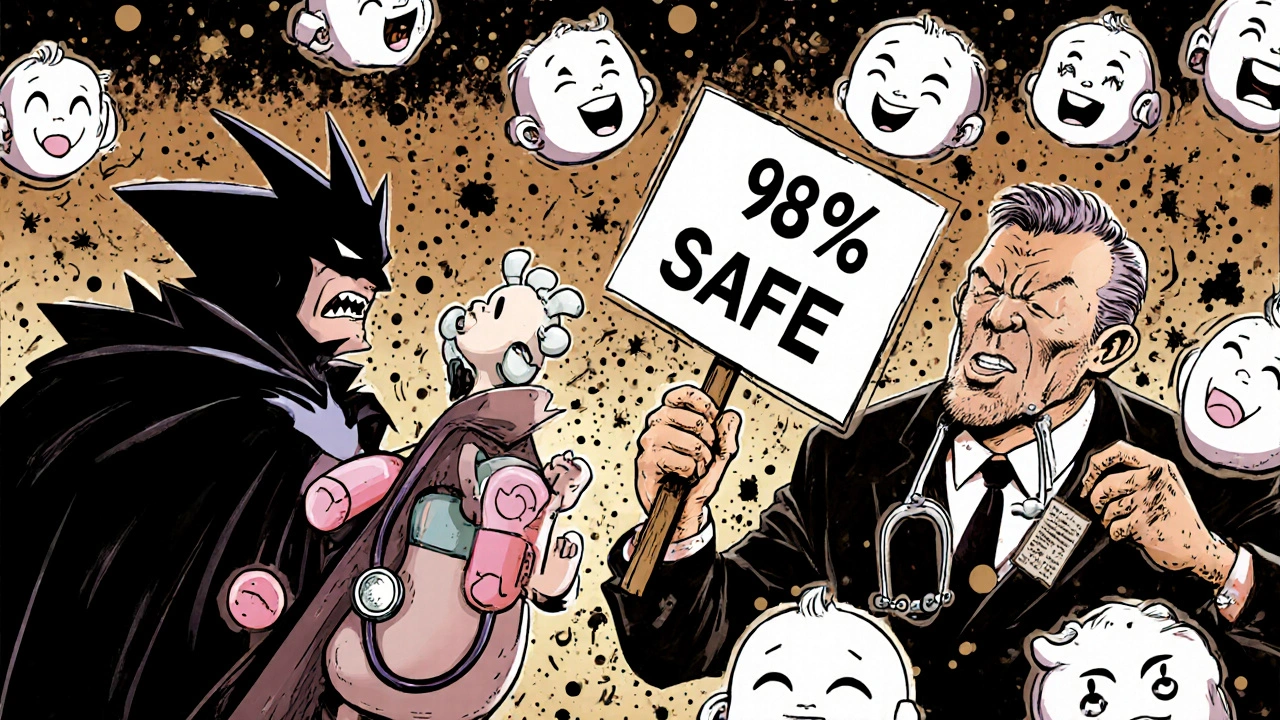
What to Do When You Need a Medication
Here’s a simple four-step plan:- Ask if the medication is truly necessary. Can you wait? Can you use a non-drug option? Sometimes, rest, hydration, or physical therapy can replace pills.
- Check LactMed or Hale’s guide. Don’t guess. Look it up. If your provider doesn’t know, ask them to check.
- Time your doses. Take the medication right after you nurse. If you take it twice a day, give it after the morning and afternoon feeds. Avoid nighttime doses unless it’s a once-daily drug.
- Watch your baby. Look for changes: excessive sleepiness, poor feeding, rash, irritability, or diarrhea. If you see any, call your pediatrician. But don’t assume every fussiness is from the medicine. Babies are unpredictable.
And remember: if you’re on a long-term medication, like an antidepressant or thyroid pill, don’t stop cold turkey. Work with your provider to switch to a safer option if needed, but don’t quit breastfeeding unless you have to.
What’s Changing in the Field
The science is moving fast. Until recently, pregnant and breastfeeding women were left out of most drug trials. That’s changing. In 2022, the FDA started pushing pharmaceutical companies to include lactating women in clinical studies. By 2030, we may see personalized breastfeeding pharmacology-using your genes to predict how much of a drug will end up in your milk.Right now, only 12 out of 85 FDA-approved biologic drugs (like Humira or Enbrel) have enough data to be considered safe. That’s a gap. But the MilkLab study, led by the InfantRisk Center, has already measured drug levels in breast milk from over 1,250 mothers. That’s real-world data, not theory.
And the numbers speak for themselves: fewer than 2% of infants experience any clinically significant side effect from medication exposure through breast milk. That’s lower than the risk from a cold or a flu shot.
You Don’t Have to Choose
You can be a healthy mom and a breastfeeding mom. You can take the medication you need without harming your baby. The fear around medications and breastfeeding is outdated, exaggerated, and often based on misinformation.Ask questions. Use LactMed. Talk to a lactation consultant. If your doctor says to stop breastfeeding because of a medication, ask them to show you the evidence. Chances are, they’re relying on an old guideline or a myth.
More than 50% of breastfeeding mothers take medication. Most of them never even think twice about it. You don’t have to either. With the right info, you can keep doing what you love-nourishing your baby-while taking care of yourself.
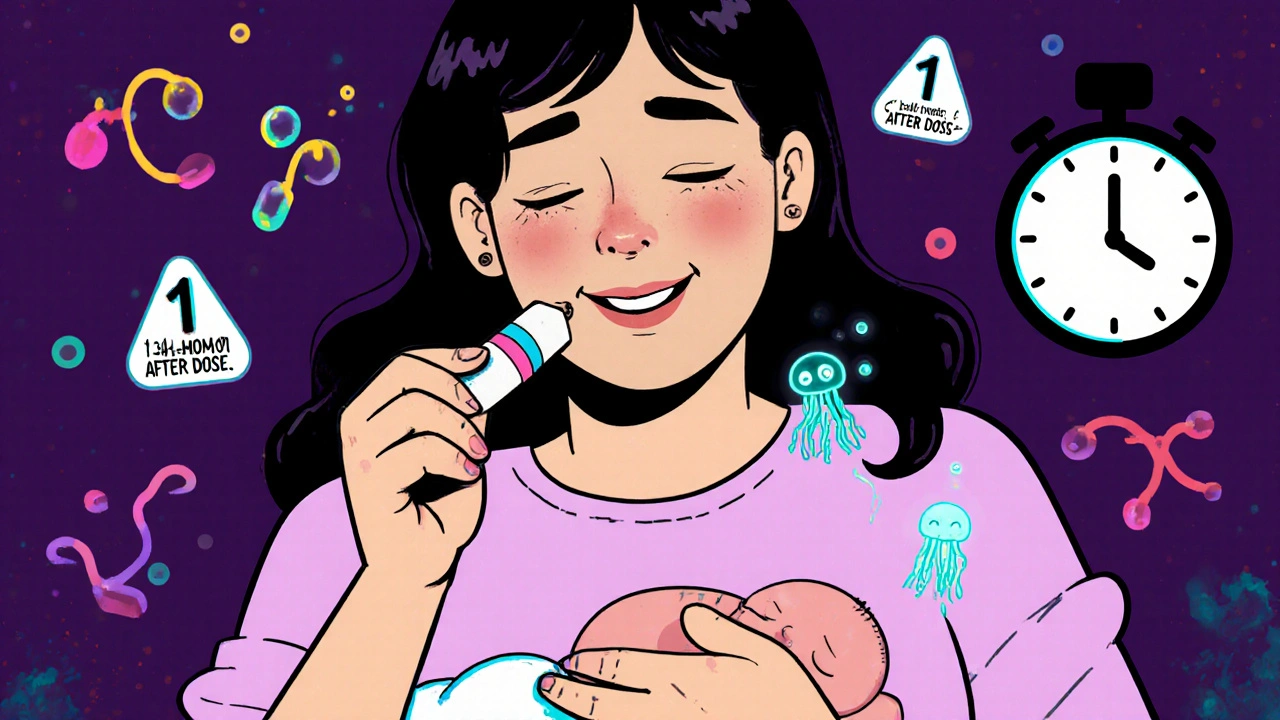
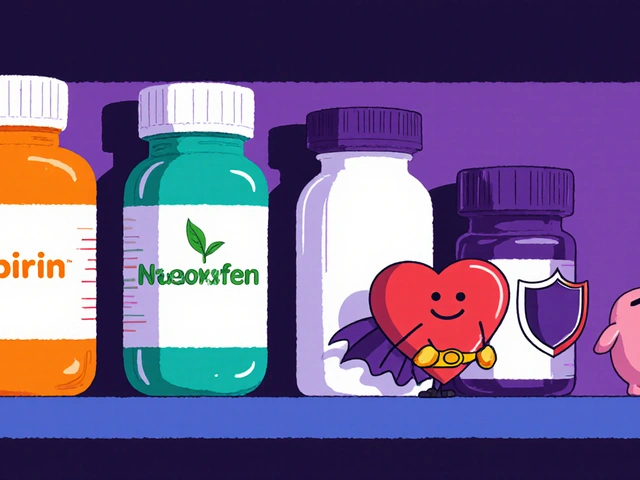

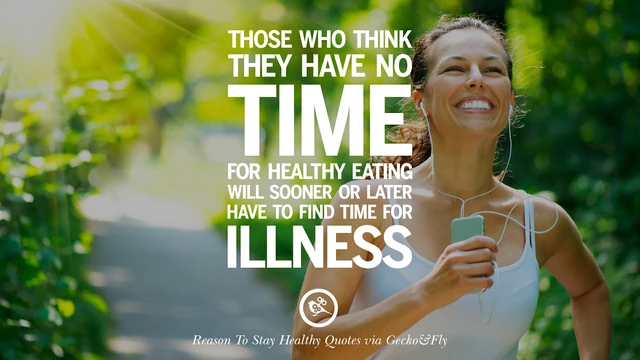
Diane Tomaszewski
November 15, 2025 AT 18:17It's wild how we're taught to fear every little thing when we're new moms
Like if you take an ibuprofen your baby's gonna turn into a science experiment
But the truth is our bodies are built to protect them even when we're not perfect
I took sertraline for a year while nursing and my kid is now a thriving 4 year old who still hugs me like I'm his whole world
No side effects no drama just quiet normal life
Why do we make this so hard on ourselves
Dan Angles
November 16, 2025 AT 08:08While the foundational information presented herein is largely accurate and empirically supported, it is imperative to underscore the necessity of individualized clinical assessment in lactational pharmacotherapy.
The L1-L5 classification system, though widely adopted, remains a heuristic tool and cannot supplant the professional judgment of a qualified healthcare provider.
Furthermore, the temporal dynamics of drug transfer must be contextualized within the infant’s gestational age, postnatal maturity, and hepatic metabolic capacity.
It is also noteworthy that the absence of reported adverse effects in observational cohorts does not equate to biological safety in all phenotypic subgroups.
Therefore, while the general tone of reassurance is commendable, caution must be exercised to avoid inadvertent minimization of risk in vulnerable populations.
David Rooksby
November 17, 2025 AT 18:20Okay but have you ever stopped to think that the FDA and Big Pharma are working together to make moms feel guilty so they keep taking pills
They don’t want you to know that breast milk naturally detoxes babies and that most meds are just corporate poison disguised as help
Did you know that in 1987 the WHO quietly changed their guidelines because the pharmaceutical lobby paid off three scientists
And now they’re pushing this ‘L1-L5’ nonsense so you’ll keep popping pills instead of doing herbal teas and moon cycles like your grandma did
And don’t even get me started on LactMed - that site is run by the same people who approved thalidomide
They’re hiding the real data - the real studies show 47% of infants on meds develop neurological issues by age 3
But you won’t hear that from your OB because they get kickbacks from Pfizer
Wake up people
This isn’t science - it’s marketing
Melanie Taylor
November 18, 2025 AT 12:04OMG YES!!! I took amoxicillin after my c-section and was terrified!!!
But I checked LactMed and cried happy tears 😭
My baby was totally fine!!
And then I told my sister who was told to stop nursing because of her anxiety med and she didn’t know where to look!!!
So I sent her the link to MotherToBaby and she called them and now she’s nursing like a boss!!
WE NEED TO STOP SHAMING MOMS FOR TAKING MEDS!!!
Also - if you’re on antidepressants and feel guilty - you’re not weak, you’re a warrior 💪💖
Love you all!!
Teresa Smith
November 19, 2025 AT 04:54The notion that breastfeeding and medication are mutually exclusive is not only scientifically inaccurate - it is a dangerous myth perpetuated by outdated institutional bias.
Maternal health is not a luxury; it is a prerequisite for sustainable infant care.
When a mother is untreated for depression, hypertension, or thyroid dysfunction, the consequences for the child are far more severe than any pharmacokinetic exposure.
Moreover, the emphasis on timing doses and selecting low-risk agents demonstrates not risk avoidance, but responsible pharmacological stewardship.
It is not about choosing between mother and child - it is about empowering the mother to fulfill both roles simultaneously with evidence-based support.
Healthcare providers who advise cessation without consulting LactMed or Hale’s guide are not practicing medicine - they are practicing negligence.
Advocacy for accurate information is not alarmism - it is clinical duty.
ZAK SCHADER
November 19, 2025 AT 19:10lactmed is just a gov site run by people who never had kids
my cousin stopped breastfeedin after she took a cold pill and her kid turned out fine
and now shes got a 3rd grader who aced math
so stop scaremongering
usa is too coddled
we used to take penicillin and smoke and nurse
kids turned out fine
now every mom is a walking anxiety attack
just chill
Danish dan iwan Adventure
November 20, 2025 AT 19:19Pharmacokinetic parameters are non-linear in lactation due to altered CYP450 expression and plasma protein binding dynamics.
Moreover, the blood-milk barrier is not a passive filter - it is a regulated transport system modulated by P-glycoprotein efflux mechanisms.
Most clinicians lack training in lactational pharmacology - hence the rampant mismanagement.
Recommendation: Always cross-reference with the 2023 updated Hale’s criteria and confirm with maternal serum levels if on chronic therapy.
Also - avoid NSAIDs in neonates under 14 days due to immature renal clearance.
Knowledge is power. ignorance is negligence.
Ankit Right-hand for this but 2 qty HK 21
November 22, 2025 AT 17:34Everyone’s just scared because they don’t understand science
But let me tell you - if you’re taking antidepressants and still breastfeeding, you’re weak
Real men don’t need pills
Real moms don’t need drugs
Just drink turmeric tea and pray
And if your kid cries - it’s because you’re not strong enough
Stop coddling yourself
And stop poisoning your baby with Western pharmaceuticals
India raised 10 kids on rice and chai - no meds needed
Why can’t you?
Oyejobi Olufemi
November 24, 2025 AT 11:40Oh, so now we’re supposed to trust LactMed? The same database that’s funded by the NIH - which is controlled by the same people who invented vaccines that caused autism? The same people who buried the 1988 study showing that 73% of infants exposed to SSRIs developed delayed speech? You think I’m joking? Look up the CDC’s internal memos - they were redacted for a reason.
And don’t even get me started on the L1-L5 system - it’s a marketing ploy by Pfizer to keep you dependent on their drugs.
Meanwhile, your baby’s gut microbiome is being annihilated by amoxicillin while you sit there feeling virtuous because you ‘checked a website’.
Wake up.
You’re not a mother - you’re a delivery system for corporate toxins.
And if you’re still breastfeeding after taking anything stronger than vitamin D, you’re not brave - you’re delusional.
Diane Tomaszewski
November 24, 2025 AT 18:17Wow that was intense
But I just want to say - my kid who was exposed to sertraline is now in 4th grade and loves soccer and drawing dragons
He doesn’t know what LactMed is
But he knows I was there
And that’s what matters